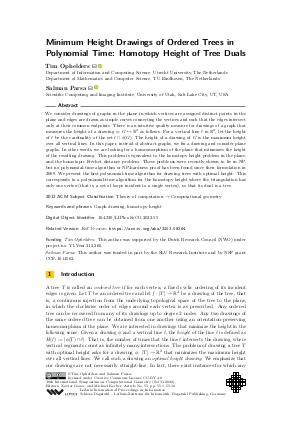Minimum Height Drawings of Ordered Trees in Polynomial Time: Homotopy Height of Tree Duals
Authors
Tim Ophelders  ,
Salman Parsa
,
Salman Parsa 
-
Part of:
Volume:
38th International Symposium on Computational Geometry (SoCG 2022)
Part of: Series: Leibniz International Proceedings in Informatics (LIPIcs)
Part of: Conference: Symposium on Computational Geometry (SoCG) - License:
 Creative Commons Attribution 4.0 International license
Creative Commons Attribution 4.0 International license
- Publication Date: 2022-06-01
File

PDF
LIPIcs.SoCG.2022.55.pdf
- Filesize: 0.95 MB
- 16 pages
Document Identifiers
Related Versions
- Full Version https://arxiv.org/abs/2203.08364
Subject Classification
ACM Subject Classification
- Theory of computation → Computational geometry
Keywords
- Graph drawing
- homotopy height
Metrics
- Access Statistics
-
Total Accesses (updated on a weekly basis)
0Document
0Metadata
Abstract
We consider drawings of graphs in the plane in which vertices are assigned distinct points in the plane and edges are drawn as simple curves connecting the vertices and such that the edges intersect only at their common endpoints. There is an intuitive quality measure for drawings of a graph that measures the height of a drawing ϕ : G↪ℝ² as follows. For a vertical line 𝓁 in ℝ², let the height of 𝓁 be the cardinality of the set 𝓁 ∩ ϕ(G). The height of a drawing of G is the maximum height over all vertical lines. In this paper, instead of abstract graphs, we fix a drawing and consider plane graphs. In other words, we are looking for a homeomorphism of the plane that minimizes the height of the resulting drawing. This problem is equivalent to the homotopy height problem in the plane, and the homotopic Fréchet distance problem. These problems were recently shown to lie in NP, but no polynomial-time algorithm or NP-hardness proof has been found since their formulation in 2009. We present the first polynomial-time algorithm for drawing trees with optimal height. This corresponds to a polynomial-time algorithm for the homotopy height where the triangulation has only one vertex (that is, a set of loops incident to a single vertex), so that its dual is a tree.
Cite As Get BibTex
Tim Ophelders and Salman Parsa. Minimum Height Drawings of Ordered Trees in Polynomial Time: Homotopy Height of Tree Duals. In 38th International Symposium on Computational Geometry (SoCG 2022). Leibniz International Proceedings in Informatics (LIPIcs), Volume 224, pp. 55:1-55:16, Schloss Dagstuhl – Leibniz-Zentrum für Informatik (2022)
https://doi.org/10.4230/LIPIcs.SoCG.2022.55
BibTex
@InProceedings{ophelders_et_al:LIPIcs.SoCG.2022.55,
author = {Ophelders, Tim and Parsa, Salman},
title = {{Minimum Height Drawings of Ordered Trees in Polynomial Time: Homotopy Height of Tree Duals}},
booktitle = {38th International Symposium on Computational Geometry (SoCG 2022)},
pages = {55:1--55:16},
series = {Leibniz International Proceedings in Informatics (LIPIcs)},
ISBN = {978-3-95977-227-3},
ISSN = {1868-8969},
year = {2022},
volume = {224},
editor = {Goaoc, Xavier and Kerber, Michael},
publisher = {Schloss Dagstuhl -- Leibniz-Zentrum f{\"u}r Informatik},
address = {Dagstuhl, Germany},
URL = {https://drops.dagstuhl.de/entities/document/10.4230/LIPIcs.SoCG.2022.55},
URN = {urn:nbn:de:0030-drops-160631},
doi = {10.4230/LIPIcs.SoCG.2022.55},
annote = {Keywords: Graph drawing, homotopy height}
}
Author Details
- Department of Information and Computing Science, Utrecht University, The Netherlands
- Department of Mathematics and Computer Science, TU Eindhoven, The Netherlands
Funding
- Ophelders, Tim: This author was supported by the Dutch Research Council (NWO) under project no. VI.Veni.212.260.
- Parsa, Salman: This author was funded in part by the SLU Research Institute and by NSF grant CCF-1614562.
References
-
Hugo A Akitaya, Maarten Löffler, and Irene Parada. How to fit a tree in a box. In Proceedings of the 26th International Symposium on Graph Drawing and Network Visualization (GD 2018), pages 361-367. Springer, 2018.

-
Therese Biedl, Erin Wolf Chambers, David Eppstein, Arnaud de Mesmay, and Tim Ophelders. Homotopy height, grid-major height and graph-drawing height. In Proceedings of the 27th Graph Drawing and Network Visualization (GD 2019), pages 468-481. Springer, 2019.

-
Benjamin Burton, Erin Chambers, Marc van Kreveld, Wouter Meulemans, Tim Ophelders, and Bettina Speckmann. Computing optimal homotopies over a spiked plane with polygonal boundary. In Proceddings of the 25th Annual European Symposium on Algorithms (ESA), 2017.

- Erin Wolf Chambers, Gregory R Chambers, Arnaud de Mesmay, Tim Ophelders, and Regina Rotman. Constructing monotone homotopies and sweepouts. arXiv preprint, 2017. URL: http://arxiv.org/abs/1704.06175.
-
Erin Wolf Chambers, Arnaud de Mesmay, and Tim Ophelders. On the complexity of optimal homotopies. In Proceedings of the 29th Annual Symposium on Discrete Algorithms (SODA 2018), pages 1121-1134, 2018.

-
Erin Wolf Chambers and David Letscher. On the height of a homotopy. In Canadian Conference on Computational Geometry (CCCG), volume 9, pages 103-106, 2009.

-
Moon-Jung Chung, Fillia Makedon, Ivan Hal Sudborough, and Jonathan Turner. Polynomial time algorithms for the min cut problem on degree restricted trees. SIAM Journal on Computing, 14(1):158-177, 1985.

-
Michael R Garey and David S Johnson. Computers and intractability, volume 174. Freeman San Francisco, 1979.

-
F Gavril. Some NP-complete problems on graphs. In Proc. Conf. on Inform. Sci. and Systems, 1977, pages 91-95, 1977.

-
Sariel Har-Peled, Amir Nayyeri, Mohammad Salavatipour, and Anastasios Sidiropoulos. How to walk your dog in the mountains with no magic leash. Discrete & Computational Geometry, 55(1):39-73, 2016.

-
Thomas Lengauer. Upper and lower bounds on the complexity of the min-cut linear arrangement problem on trees. SIAM Journal on Algebraic Discrete Methods, 3(1):99-113, 1982.

-
Debajyoti Mondal, Muhammad Jawaherul Alam, and Md. Saidur Rahman. Minimum-layer drawings of trees. In Naoki Katoh and Amit Kumar, editors, WALCOM: Algorithms and Computation, pages 221-232. Springer, 2011.

-
B. Monien and I.H. Sudborough. Min cut is NP-complete for edge weighted trees. Theoretical Computer Science, 58(1):209-229, 1988.

-
Yossi Shiloach. A minimum linear arrangement algorithm for undirected trees. SIAM Journal on Computing, 8(1):15-32, 1979.

-
Mihalis Yannakakis. A polynomial algorithm for the min-cut linear arrangement of trees. Journal of the ACM, 32(4):950-988, 1985.

